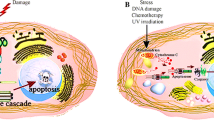Summary
Substitution of various metal compounds for aluminum ammonium sulfate in the aluminum-morin procedure developed by Malinin (1978) revealed that only one compound (indium trichloride) yielded fluorescent patterns in mastocytoma cells and isolated nuclei resembling those of the standard procedure. All other compounds tested, including zinc acetate, zinc iodide, zinc sulfate, calcium chloride, beryllium nitrate, and zirconium nitrate, produced either only slight enhancement of fluorescence over that obtained in control material treated with morin alone; or the fluorescence was no greater than that of control material. A microfluorometric comparison of thymocyte and 2c hepatocyte nuclei stained by either the indiumor aluminum-morin procedures revealed that the fluorescence of the more loosely organized chromatin of 2c hepatocyte nuclei was 30–40% greater than that of the more condensed chromatin of thymocyte nuclei. In addition, the fluorescence of indium-pretreated nuclei was either the same or slightly greater than that of aluminum-pretreated nuclei. Extraction with RNase always resulted in a loss of fluorescence in aluminum-pretreated nuclei; however, somewhat different results were obtained in indium-pretreated nuclei: the fluorescence of thymocyte nuclei declined (but not so much as that of nuclei pretreated with aluminum), and hepatocyte nuclei either displayed no change in fluorescence or their fluorescence increased slightly. Since both aluminum- and indium-morin procedures, used with or without RNase extraction, yield consistently disparate values in nuclei displaying differing degrees of chromatin condensation, it seems likely that these procedures might be useful in studies requiring the demonstration of structural differences in chromatin.
Similar content being viewed by others
References
Adolph KW, Cheng SM, Laemmli UK (1977) Role of non-histone proteins in metaphase chromosome structure. Cell 12:805–816
Auer G (1972) Cytochemical properties of nuclear chromatin as demonstrated by the colloidal iron binding technique. Exp Cell Res 75:237–244
Brown SW (1966) Heterochromatin. Science 151:417–425
Chaplin AJ, Grace SR (1976) An evaluation of some complexing methods for the histochemistry of calcium. Histochemistry 47:263–269
Cowden RR, Curtis SK (1981) Microfluorometric investigations of chromatin structure. I. Evaluation of nine DNA-specific fluorochromes as probes of chromatin organization. Histochemistry 72:11–23
Curtis SK, Cowden RR (1980) The effects of fixation and preparation on three quantitative fluorescent cytochemical procedures. Histochemistry 68:29–38
Feigl F, Anger V (1972) Spot tests in inorganic analysis. 6th ed. Elsevier, Amsterdam
Hadlaczky G, Sumner AT, Ross A (1981a) Protein-depleted chromosomes. I. Structure of isolated protein-depleted chromosomes. Chromosoma 81:537–555
Hadlaczky G, Sumner AT, Ross A (1981b) Protein-depleted chromosomes. II. Experiments concerning the reality of chromosome scaffolds. Chromosoma 81:557–567
Hall CT, Hansen PA (1962) Chelated azo dyes used as counterstains in the fluorescent antibody technic. Zentralbl Bakteriol (1st Abt) Orig 184:548–554
Immers J, Markman B, Runnström J (1967) Nuclear changes in the course of the development of the sea urchin studied by means of Hale staining. Exp Cell Res 47:425–442
Jeppesen PGN, Bankier AT, Sanders L (1978) Non-histone proteins and the structure of metaphase chromosomes. Exp Cell Res 115:293–302
Lawson GM, Cole RD (1979) Selective displacement of histone H1 from whole HeLa nuclei: effect on chromatin structure in situ as probed by micrococcal nuclease. Biochemistry 18:2160–2166
Lief RC, Easter HN, Warters RL, Thomas RA, Dunlap LA, Austin MF (1971) Centrifugal cytology. I. A quantitative technique for the preparation of glutaraldehyde-fixed cells for the light and scanning electron microscope. J Histochem Cytochem 19:203–215
Malinin GI (1978) Permanent fluorescent staining of nucleic acids in isolated cells. J Histochem Cytochem 26:1018–1020
Marzilli LG, Kistenmacher TJ, Eichhorn GL (1980) Structural principles of metal ion-nucleotide and metal ion-nucleic acid interactions. In: Spiro TG (ed) Nucleic acid-metal ion interactions. John Wiley and Sons, New York, pp 179–250
Ringertz NR (1969) Cytochemical properties of nuclear proteins and deoxyribonucleoprotein complexes in relation to nuclear function. In: Lima-De-Faria A (ed) Handbook of molecular cytology. American Elsevier, New York, pp 656–684
Romen W, Rüter A, Saito K, Harms H, Aus HM (1980) Relationship of ploidy and chromatin condensation in the rat liver, Moreover a comparison of the nuclear texture in sections and touch preparations. Histochemistry 67:249–256
Schmitz KS, Ramanathan B (1980) Generation of a third-order folded structure for chromatin. J Theor Biol 83:297–311
Spiro TG (ed) (1980) Nucleic acid-metal ion interactions. John Wiley and Sons, New York
Stoward PJ (1967) Studies in fluorescence histochemistry. III. The demonstration with salicylhydrazide of the aldehydes present in periodate-oxidized mucosubstances. J R Microsc Soc 87:247–257
Studzinski GP (1965) Selective binding of zinc by basic proteins of the HeLa cell nucleolus. J Histochem Cytochem 13:365–375
Swift H (1966) The quantitative cytochemistry of RNA. In: Wied GL (ed) An introduction to quantitative cytochemistry. Academic Press, New York, pp 355–386
Thoma F, Koller T, Klug A (1979) Involvement of histone H1 in the organization of the nucleosome and of the salt-dependent superstructures of chromatin. J Cell Biol 83:403–427
Watson ML, Aldridge WG (1961) Methods for the use of indium as an electron stain for nucleic acids. J Biophys Biochem Cytol 11:257–272
Watson ML, Aldridge WG (1964) Selective electron staining of nucleic acids. J Histochem Cytochem 12:96–103
Wray W, Conn PM, Wray VP (1977) Isolation of nuclei using hexylene glycol. In Stein G, Stein J, Kleinsmith LJ (eds) Methods in cell biology, Vol 16. Academic Press, New York, pp 69–86
Yarom R, Maunder C, Scripps M, Hall TA, Dubowitz V (1975) A simplified method of specimen preparation for x-ray microanalysis of muscle and blood cells. Histochemistry 45:49–59
Zayetz VW, Bavykin SG, Karpov VL, Mirzabekov AD (1981) Stability of the primary organization of nucleosome core particles upon some conformational transitions. Nucleic Acids Res 9:1053–1068
Author information
Authors and Affiliations
Rights and permissions
About this article
Cite this article
Cowden, R.R., Curtis, S.K. Microfluorometric investigations of chromatin structure. Histochemistry 72, 391–400 (1981). https://doi.org/10.1007/BF00501781
Received:
Issue Date:
DOI: https://doi.org/10.1007/BF00501781




